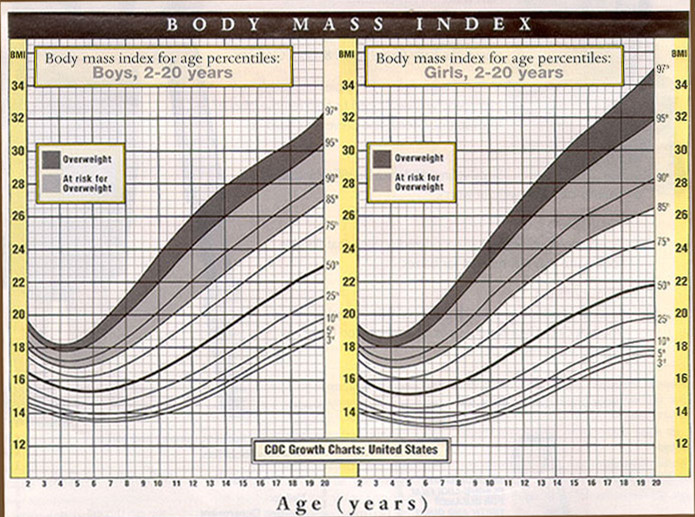For many years, medical professionals have used measurements of height and weight to assess the physical growth of a child of the same age. In current medical practices, a new method has been devised: body mass index (BMI). Healthcare professionals use BMI to assess whether a child's weight is suitable for their height and age. Below, you will find links to a BMI chart for children, both for girls and boys.
What Is BMI?
BMI, also Body Mass Index, refers to a person's kilograms of weight divided by the square of one's height in meters. The formula can be:

Or you can calculate as:

For children and teens, BMI is age and sex specific, often regarded as BMI-for-age. It is important to know whether your child is at a healthy body weight, as too little or too much body fat can both lead to serious health implications.
The American Academy of Pediatrics suggests the use of BMI to screen for weight issues in children from the age of 2. For children who are under age 2, you can refer to the World Health Organization's standards. For children and teens, BMI is generally used to screen for possible weight issues and health-related problems. To diagnose the indicated issues from the BMI chart, further tests will be required.
How to Interpret BMI Chart for Children

Your child's weight category is determined by their percentile. Different readings for different ages are explained below:
|
BMI Figures |
For Children Aged 2 to 5 (Not Include 5) |
For Children Aged 5 – 19 |
|---|---|---|
|
Below 3rd Percentile |
Risk of being underweight |
Risk of being underweight |
|
3rd Percentile to Below 85th Percentile |
Considereda healthy weight |
Considereda healthy weight |
|
85th Percentile to 97th Percentile |
Risk of being overweight |
Consideredoverweight |
|
Above the 97th Percentile to 99.9th Percentile |
Considered overweight |
Considered obese |
|
Above the 99.9th Percentile |
Considered obese |
Considered severely obese |
How to Calculate BMI for Children at Home
To ensure an accurate measurement of BMI, it is important that you measure their height and weight correctly and without error. A small fraction error can make a big difference on the final results. To ensure an accurate measurement, follow the steps below for height and weight:
How to Get Accurate Height Results
- Ensure your child is not wearing any shoes, braids, hairclips, or other accessories.
- Take the measurement whilst your child is standing upon an uncarpeted surface, and against a flat wall.
- Ensure that your child is standing straight, with the back of their head, shoulders, back, and heels touching the wall, and their eyes looking straight forward.
- Acquire a straight, flat item (such as a ruler), and place it at a 90 degree angle on the wall, forming an L shape, then gently lower it until it is firmly upon your child's head.
- Using a pencil, place a mark on the wall where the ruler meets it (this will be the height of your child). Then use a measuring tape or similar apparatus to measure from the mark on the wall to the ground.
- For increased accuracy, you can convert the measurement to the nearest tenth of a centimeter (cm), or eight of an inch. For BMI purposes, divide the height in centimeters by 100 to get the height in meters; inches require no conversion for use in the standard calculation. f you wish to concert inches to centimeters, multiply the height in inches by 2.54, then divide that by one hundred to get the height in meters. For example, with a height of 47 inches, you would do: 47 inches*2.54=120 centimeters; 120 centimeters/100=1.2 meters.
How to Get Accurate Weight
- Position a digital scale onto a hard, flat, and even surface.
- Ensure your child is wearing light clothing, and is without shoes or accessories.
- Have your child stand flat on the center of the scales, and remain in position until the reading has been recorded. If possible, try to measure the weight to one decimal point.
- For BMI purposes, ensure the weight is either measured in, or converted to kilograms. If you have recorded your child's weight in pounds, divide the reading by 2.2 to obtain their weight in kilograms.For example, with a weight of 85 pounds you would do: 85 pounds/2.2=38 kilograms.
If you don't want to do the calculation work by yourself, the BMI CALCULATOR can be helpful.
